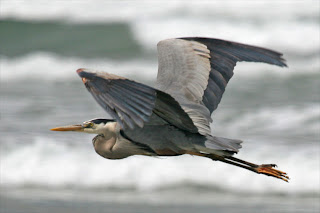True Wild Life | Heron | The heron is a large species of bird that inhabits wetlands and areas that are close to lakes, ponds and rivers. Some species of heron are also known as egrets and bitterns instead of being called herons. There are 64 different species of heron found inhabiting the wetlands around the world. Herons are commonly found in Europe and North America along with the more temperate regions of Africa, Asia and Australia. Herons are commonly confused with the stalk which is another large species of bird, however the fact that herons fly with their necks in rather than outstretched is on the main differences between herons and stalks.
The great blue heron found inhabiting parts of North America and as far west as the Galapagos Islands is the largest species of heron in the world and can measure nearly a meter in height. The smallest species of heron in the world is the green heron measuring less than 50 cm tall. The green heron is most commonly found in North America and Central America, and occasionally in Hawaii. All 64 different species of heron are very similar in body shape but not in size and colour. All herons have long pointed beaks which helps them to grab fish out of the water, along with long necks and thin, long legs both of which are useful to the heron as it lives it's waterside lifestyle. Herons also have enormous wings that can be nearly double the size of the heron's body.
The heron is a carnivorous species of bird, with the heron primarily feeding on fish. Herons also prey on a number of other small animals including amphibians, molluscs, snakes, insects and even small mammals and birds. The heron uses it's long pointed beak to snatch it's prey out of the water or from the ground. Due to their large size, herons have few natural predators in their wetland environment. Foxes, raccoons, minks and weasels are the herons most common predators as they predominately prey on the eggs of the heron and their young rather than the adult heron itself.
Some species of heron are known to breed in colonies but most heron species breed on their own usually in woodland close to water. Herons build their nests in tall trees so that the eggs are safe from the predators on the ground. The nest of the heron is build out try leaves and twigs by both the male heron and the female heron. The female heron lays an average of 4 eggs per clutch which hatch after an incubation period of around 1 month. Both the male heron and the female heron help to incubate their eggs and feed the tiny heron chicks. Herons live for up to 25 years.
Herons are not considered to be threatened or endangered animals although concerns have been raised about the health-risks to the world's heron populations. Pollution is a major factor in the decline of many animal populations around the world, and pollution in the water can have a devastating effect on the fish which the heron eat.





1 comment:
Poor Rabbit!!!!
Post a Comment